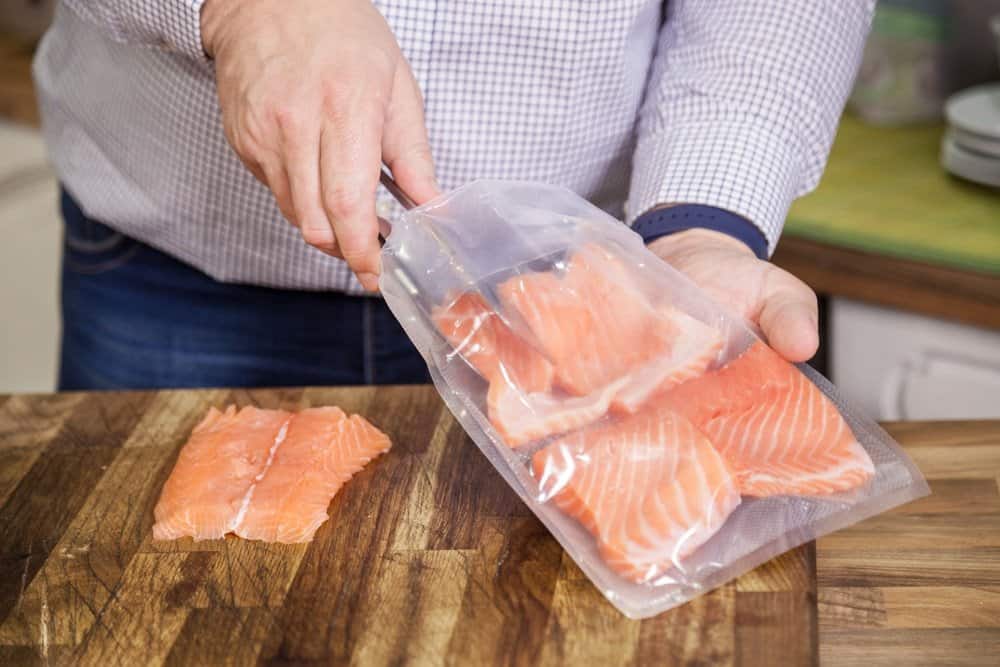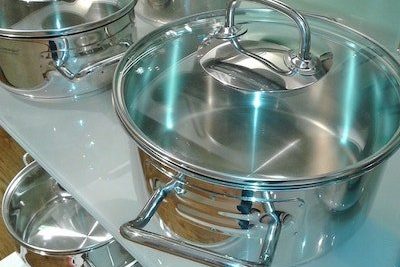What Is a Sous Vide Bag? Packaging Food for Sous Vide Cooking
In sous vide cooking, it’s important to package the food correctly in order to get this cooking process right. So what is a sous vide bag? A sous vide bag is the bag that holds the food, which you place in a water bath to cook it sous vide!
Here I’ll describe the different types of sous vide bags and aim to help you understand how to package your food for sous vide cooking. First, I’ll address how to prep your food (including trimming and seasoning) before getting into the details of sous vide bags and packaging options and methods.

Trimming Meat Before Sous Vide Packaging
Not all cuts of meat are immediately ready to cook when you buy them. Before bagging meat for sous vide cooking, make sure to remove the bones from fish, remove the membrane from ribs, or trim excess fat.
Trimming excess fat is especially important because, since you don’t reach extremely high temperatures when cooking most types of meat sous vide, the fat doesn’t get rendered as much as it would with other cooking methods.
Seasoning Food Before Sous Vide Packaging
With sous vide cooking, not only do you want your food perfectly cooked at the right temperature, but you also want your food to taste great! Before bagging is the time to season your food for sous vide cooking.
Here’s what you can use for seasoning:
- Salt and pepper
- Dry spices such as garlic powder, onion powder, curry powder, paprika, Italian seasoning, etc.
- Fresh herbs such as rosemary, thyme, basil, etc.
- Oil or butter (this also helps prevent the food from sticking to the bag)
- Sauces
- Marinade
Click here for a comprehensive guide on seasoning and when it should be done in sous vide cooking.
What Can I Use to Package Food for Sous Vide Cooking?
A sous vide bag is the bag you use to put your food in before placing it in the water bath to cook it sous vide style. It definitely matters what type of bag you use before putting in the container when cooking sous vide. Let’s dive into your options for sous vide packaging.
Zipper Lock/Resealable Bags
This is your standard resealable or zipper lock plastic bag you use to put your sandwiches in for a packed lunch.
Things to note:
- They’re cheap, available in most stores or online, and you probably already have some in your pantry or kitchen
- You want to use a high-quality brand like Ziploc, Glad, or Hefty
- Freezer bags are preferable because they’re sturdier and you won’t have to worry about the bag breaking and leaking
- Gallon size is great for fitting more food in a single bag
- Great for pretty much anything you want to cook from steaks and pork chops to seafood or vegetables and even eggs
- Not durable enough for bone-in meats, heavier servings, or longer cook times at higher temperatures. However, you can double bag for these conditions and be okay
- BPA-free options
Vacuum Sealer Bags
Vacuum sealer bags are the bags designed for use with a vacuum sealer. What’s great is that you actually don’t have to vacuum seal these bags with a vacuum sealer. Instead, you can clip the top of the bag over the side of the pot or hold it in place with a lid.
Many people do still prefer to use a vacuum sealer, so they don’t have to worry about getting all of the air out of the bag (see below for how to do this) or worry about leaks.
Check out my article here to learn more about the need for vacuum sealers with sous vide.
Things to note:
- Easy to get online
- Sealing with a vacuum sealer gives a strong seal with no leaks but isn’t required
- You can get reusable bags with a mini electric vacuum sealer at a fraction of the cost of a regular vacuum sealer
- Sealing with a vacuum sealer keeps food fresher for longer, whether it’s cooked or uncooked (which is especially ideal if you plan to use your sous vide machine or meal prep)
- Very durable
- Work under any sous vide temperature and are designed to withstand higher temperatures (above 158°F / 70°C)
- Can be used for any and all types of food, including bone-in meats
- BPA-free options
Silicone Bags
Silicone bags or silicone pouches are a more recent option for sous vide packaging and are an environmentally friendly solution for cooking sous vide without plastic.
Things to note:
- Can be found online
- Great non-plastic option
- Can withstand very high temperatures
- Very durable like vacuum sealer bags but don’t require a vacuum sealer
- Easy to use and seal like zipper lock bags
- Leakproof
- Stain and odor resistant
- Can be reused over and over again
- Safe to recycle once no longer usable
- BPA-free
- Can be used for any and all types of food
- Due to the thickness of the silicone, it’s recommended to cook for an additional 5 minutes
Canning Jars
Canning jars or Mason jars used for pickling or canning are another great solution for how to sous vide without plastic.
Things to note:
- Can be found online
- Great non-plastic option
- Durable, withstand high temperatures
- Preferred for recipes that start out as liquid form and what you would otherwise bake (such as custards or egg bites); also good or yogurt or pate
- Most efficient if you’re cooking the above in batches
- Not really ideal for cooking meat or seafood
- Dishwasher and freezer safe
- Odor and stain resistant
- Will usually stay submerged; if they do float, it’s okay since the food will stay at the bottom of the jar and below the waterline because of gravity
- Don’t have to worry about removing air, as you do with bags
How Much Food Can I Put in a Sous Vide Bag?

You can cook multiple pieces of meat or fish or have multiple vegetables in a single sous vide bag.
However, it’s important to remember to not overcrowd the bag. The general rule of thumb is to put just enough food that fits in a single layer within the bag and should still have a bit of room to move around. Stacking food prevents each piece of food from cooking evenly.
Also, be sure to not put too many bags in the pot or container. There should be enough room between the bags so water can circulate around each of them. Sous vide racks are helpful for this to keep the bags separated so they cook properly.
Click here to learn more about cooking multiple pieces of meat at once.
Water Immersion Method: Removing Air From Sous Vide Bags
Removing Air From Zipper Lock Bags
If you’re not using a vacuum sealer, you need to find a way to remove as much air from the bag as possible.
The best way to remove air from zipper lock bags is with the water immersion (also referred to as the water displacement) technique. Here’s how to do it:
- Place the food in the bag
- Seal the bag but not all the way; leave it a little bit open at the end
- Lower the bag into the water bath; the air will start to leave the bag as you lower it into the water
- Lower the bag until you get to the seal at the top, being careful to not allow any water to enter the bag, and then seal the rest of the bag
You can check out a video tutorial for removing air from zipper lock bags here.
Removing Air From Silicone Bags
If you have delicate food items that can break apart easily, you can remove air from silicone bags using the above method (see a video tutorial here).
Otherwise, here are the steps for the preferred method of removing air from silicone bags:
- Place food in the bag
- Seal it so it’s almost completely closed, leaving it slightly open at the end
- Lay the bag flat, and roll it from the bottom of the bag up towards the seal
- Once you reach the seal, being careful to not let any food escape from the bag, seal the remainder of the top
- Spread the food out in the bag to make sure it’s all in a single layer and there’s no stacking
You can check out a video tutorial for removing air from silicone bags here.
In Summary
There’s clearly a lot to consider when packaging food for sous vide cooking.
From my research on this topic, you definitely can’t go wrong with using a vacuum sealer and vacuum sealer bags. And if you worried about the price and/or using too many plastic bags, these reusable bags that come with a mini electric vacuum sealer are an awesome alternative.
Silicone bags are an excellent option too, if you’re not ready to purchase a vacuum sealer just yet and want to save plastic.
I think resealable zipper lock bags are also great (and cheap), but remember to be careful with using these at higher temperatures.
Hopefully you found this guide on how to package food for sous vide cooking helpful!









